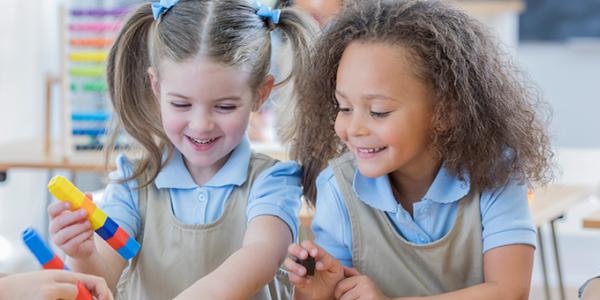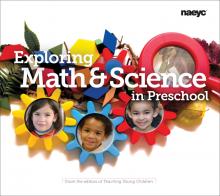Excerpt from Exploring Math and Science in Preschool

Sorting Activities for Preschoolers
by William C. Ritz
Imagine a supermarket where goods are arranged alphabetically, where a single aisle displays everything from lemons to light bulbs to liver! Most of us would find it difficult to shop for what we need in such a store. Fortunately, grocers arrange products into sensible and familiar categories that make shopping easy.
In our everyday lives, we often arrange objects, ideas, and events into convenient groups or categories. Early experiences in sorting things into groups help young learners to better observe how things are alike and different—essential early literacy and math skills. Preschools typically have a variety of materials on hand that children can sort in different ways, and most preschoolers will do so with little encouragement. Becoming increasingly skilled at sorting helps learners of all ages to cope with all the information around us in the modern world.
Button Box
Years ago, my mother kept a box filled with spare buttons. If you lost a button, she would search the button box to find the best match. A collection of buttons of different shapes, colors, sizes, and materials can also be a wonderful resource for preschool learners. (Caution: Remind children not to put buttons in their mouths, as they are a choking hazard!)
Gather a small group of five or six children and provide individual sectioned containers, such as egg cartons or ice cube trays, and plastic magnifiers. Invite each child to select 10 to 15 buttons of various shapes, colors, sizes, and materials. Encourage the children to examine the buttons and describe how they are alike and how they are different. Invite the children to use the magnifiers to make more detailed observations about the designs of the buttons.
Next, challenge the children to put buttons of the same color, size, or design into the container sections. Explain that this is called sorting. Ask open-ended questions that lead children to explain why they grouped their buttons in a particular way. After children have sorted their buttons one way, suggest that they empty the containers to pile the buttons together again. Say, “Now you can sort your buttons again. How do you want to sort them this time?” Ask the children to describe why they have chosen to sort the buttons as they have. Point out that any sorting choice is okay; there is no one correct way.
When the children become familiar with the task, encourage them to sort other objects as well—shapes, coins, seeds, beads, and so on.
Curriculum Connections
Sorting activities connect easily with other areas of the curriculum. Here are a few examples of curriculum connections teachers and children can explore.
Science and Nature
Take the children for a walk to collect leaves from different kinds of trees and with different colors. Encourage them to examine the leaves to find interesting characteristics. Talk about differences and similarities. “What other leaves are like this one?” “Are all the leaves from one kind of tree the same size?” “The same color?” Ask the children to sort the leaves by similar characteristics: size, color, shape, and so on. Encourage children to re-sort leaves several different ways, based on a variety of traits.
Math
A set is a collection of objects considered as a whole—a collection of things that share a particular property (such as the same color). When children sort objects, they are creating sets (and often subsets too). The concept of sets is important in mathematics. To support children’s early experiences in sorting, use the word set frequently to help preschoolers build a foundation for future understanding and use of this concept: “Olivia, show George your set of blue bottle caps.”
Provide children with cardboard or wooden geometric shapes. Suggest that they sort the shapes into groups. If the collection contains shapes of different colors, children can sort by color as well as shape. Remember, however, that preschoolers first learn to sort by only one characteristic at a time.
Art
Plan a leaf-pressing activity using wax paper and a warm iron. Be sure to work in small groups and supervise closely. Hang groups of finished pressings with similar properties (for example, all of the oak leaves) in one place as colorful transparencies in sunlit windows.
Use buttons from the button box to create free-form collages on construction paper or in boxes. Children might use buttons to make designs or flower shapes. They might use buttons of one color for the stem and buttons of another color for petals.
Buttons can be turned into interesting accessories. Using string or dental floss, children can thread sorted buttons, for example, alternating buttons with different characteristics to create necklaces, key chains, or bracelets.
From Exploring Math and Science in Preschool. Copyright © 2015 by the National Association for the Education of Young Children.
Learn more about this book
Resources
Recommendations
For Authors & Photographers
Catalog
Webinars
NAEYC Books List
